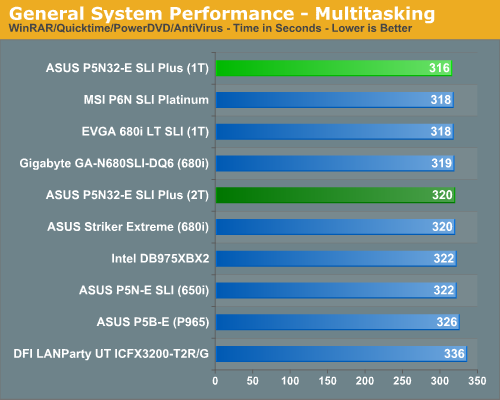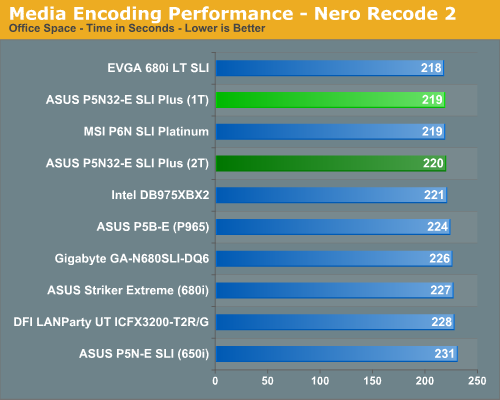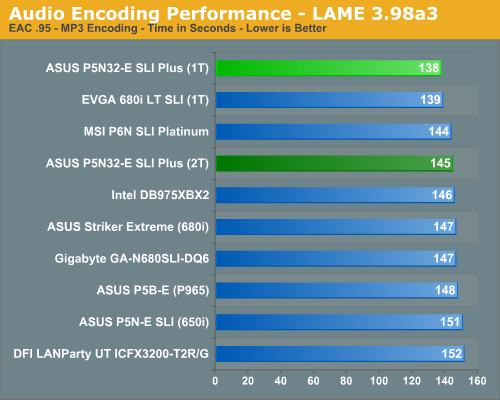ASUS P5N32-E SLI Plus: NVIDIA's 650i goes Dual x16
by Gary Key on April 2, 2007 3:30 AM EST- Posted in
- Motherboards
Multitasking Performance
We devised a script that would compress our standard test folder consisting of 444 files, ten subfolders, and 602MB worth of data, convert a 137MB High Definition QuickTime movie clip to a 37MB MPEG-4 format, play back the first two chapters of Office Space with PowerDVD, and run our AVG anti-virus program in the background. We stop the script when the file compression and video conversion are complete. This is a very taxing script for the CPU, Memory, and Storage subsystem. We also found it to be a good indicator of system stability during our overclocking testing.

The performance difference basically mirrors our PCMark 2005 tests with the ASUS, MSI, and EVGA boards finishing at the top due to great disk performance although the Intel boards consistently completed the QuickTime Conversion first. The DFI RD600 board scored last although it generated the best overall video playback results. Our differences in 1T and 2T timings in this test were minimal with WinRAR showing the only measurable benefits with our memory timings.
Media Encoding Performance
Our first encoding test is quite easy - we take our original Office Space DVD and use AnyDVD Ripper to copy the full DVD to the hard drive without compression, thus providing an almost exact duplicate of the DVD. We then fire up Nero Recode 2, select our Office Space copy on the hard drive, and perform a shrink operation to allow the entire movie along with extras to fit on a single 4.5GB DVD disc. We leave all options on their defaults except we turn off the advanced analysis option. The scores reported include the full encoding process and are represented in seconds, with lower numbers indicating better performance.

We continue to see a strong performance from the ASUS Plus board with the EVGA 680i LT SLI in our application tests finishing ever so slightly in front. We did not notice any differences in this test between 1T and 2T timings which surprised us as CPU throughput and disk access times are the critical factors affecting test scores. Media and Audio encoding are the few CPU centric tasks that NVIDIA chipsets handle well.
Audio Encoding Performance
While the media encoding prowess of the boards was superb in our initial media encoding testing, we wanted to see how they faired on the audio side. Our audio test suite consists of Exact Audio Copy v095.b4 and LAME 3.98a3. We utilize the INXS Greatest Hits CD that contains 16 tracks totaling 606MB of one time '80s hits. We set up EAC for variable bit rate encoding, burst mode for extraction, use external program for compression, and to start the external compressor upon extraction (EAC will read the next track while LAME is working on the previous track, thus removing a potential bottleneck with the optical drive). We also set the number of active threads to two to ensure both cores are active during testing. The results are presented in seconds for the encoding process, with lower numbers being better.

Our Plextor drive consistently took two minutes and nine seconds to read all sixteen tracks. This means our test systems are only utilizing one core during testing until the midway point of the extraction process where the drive speed begins exceeding the capability of the encoder and requires the use of a second thread.
As in the media encoding section, the more intensive CPU and storage system tests seem to favor the 975X over the P965/NV650i-680i/RD600 when running at the same memory timings. However, we are starting to notice a pattern in the latest NVIDIA releases where this is no longer the case, especially with 1T settings enabled on the NVIDIA chipset boards. This is especially true with the ASUS Plus board as we had a seven second difference between the two settings. We consider any results that differ greater than 5% to be noteworthy and depending upon the application, a difference that can be seen when using the systems on an every day basis.
We have almost completed the retesting all of our NVIDIA boards with 1T settings and will provide these results along with 2T timings in our next article if there are significant differences in performance. While the overall differences are minimal in the grand scheme of things, 1T performance can make a slight difference and is worth using if your RAM and motherboard can manage it.
File Compression Performance
In order to save space on our hard drives and ensure we had another CPU crunching utility, we will be reporting our file compression results with the latest version of WinRAR that fully supports multi-treaded operations and should be of particular interest for those users with dual core or multi-processor systems. Our series of file compression tests utilizes WinRAR 3.62 to compress our test folder that contains 444 files, ten subfolders, and 602MB worth of data. All default settings are utilized in WinRAR along with our hard drive being defragmented before each test.

We had stated in our EVGA 680i LT SLI article, "When you need pure CPU crunching power, the Intel chipsets win hands down." Well, today we have to eat some humble pie as the ASUS implementation of the 650i chipset is now holds the performance lead in this CPU crunching benchmark with 1T timings implemented. In fact we have an almost 6% performance difference in this benchmark between timings and to be quite honest, we thought the board was even faster than the benchmarks indicate.
We devised a script that would compress our standard test folder consisting of 444 files, ten subfolders, and 602MB worth of data, convert a 137MB High Definition QuickTime movie clip to a 37MB MPEG-4 format, play back the first two chapters of Office Space with PowerDVD, and run our AVG anti-virus program in the background. We stop the script when the file compression and video conversion are complete. This is a very taxing script for the CPU, Memory, and Storage subsystem. We also found it to be a good indicator of system stability during our overclocking testing.

The performance difference basically mirrors our PCMark 2005 tests with the ASUS, MSI, and EVGA boards finishing at the top due to great disk performance although the Intel boards consistently completed the QuickTime Conversion first. The DFI RD600 board scored last although it generated the best overall video playback results. Our differences in 1T and 2T timings in this test were minimal with WinRAR showing the only measurable benefits with our memory timings.
Media Encoding Performance
Our first encoding test is quite easy - we take our original Office Space DVD and use AnyDVD Ripper to copy the full DVD to the hard drive without compression, thus providing an almost exact duplicate of the DVD. We then fire up Nero Recode 2, select our Office Space copy on the hard drive, and perform a shrink operation to allow the entire movie along with extras to fit on a single 4.5GB DVD disc. We leave all options on their defaults except we turn off the advanced analysis option. The scores reported include the full encoding process and are represented in seconds, with lower numbers indicating better performance.

We continue to see a strong performance from the ASUS Plus board with the EVGA 680i LT SLI in our application tests finishing ever so slightly in front. We did not notice any differences in this test between 1T and 2T timings which surprised us as CPU throughput and disk access times are the critical factors affecting test scores. Media and Audio encoding are the few CPU centric tasks that NVIDIA chipsets handle well.
Audio Encoding Performance
While the media encoding prowess of the boards was superb in our initial media encoding testing, we wanted to see how they faired on the audio side. Our audio test suite consists of Exact Audio Copy v095.b4 and LAME 3.98a3. We utilize the INXS Greatest Hits CD that contains 16 tracks totaling 606MB of one time '80s hits. We set up EAC for variable bit rate encoding, burst mode for extraction, use external program for compression, and to start the external compressor upon extraction (EAC will read the next track while LAME is working on the previous track, thus removing a potential bottleneck with the optical drive). We also set the number of active threads to two to ensure both cores are active during testing. The results are presented in seconds for the encoding process, with lower numbers being better.

Our Plextor drive consistently took two minutes and nine seconds to read all sixteen tracks. This means our test systems are only utilizing one core during testing until the midway point of the extraction process where the drive speed begins exceeding the capability of the encoder and requires the use of a second thread.
As in the media encoding section, the more intensive CPU and storage system tests seem to favor the 975X over the P965/NV650i-680i/RD600 when running at the same memory timings. However, we are starting to notice a pattern in the latest NVIDIA releases where this is no longer the case, especially with 1T settings enabled on the NVIDIA chipset boards. This is especially true with the ASUS Plus board as we had a seven second difference between the two settings. We consider any results that differ greater than 5% to be noteworthy and depending upon the application, a difference that can be seen when using the systems on an every day basis.
We have almost completed the retesting all of our NVIDIA boards with 1T settings and will provide these results along with 2T timings in our next article if there are significant differences in performance. While the overall differences are minimal in the grand scheme of things, 1T performance can make a slight difference and is worth using if your RAM and motherboard can manage it.
File Compression Performance
In order to save space on our hard drives and ensure we had another CPU crunching utility, we will be reporting our file compression results with the latest version of WinRAR that fully supports multi-treaded operations and should be of particular interest for those users with dual core or multi-processor systems. Our series of file compression tests utilizes WinRAR 3.62 to compress our test folder that contains 444 files, ten subfolders, and 602MB worth of data. All default settings are utilized in WinRAR along with our hard drive being defragmented before each test.

We had stated in our EVGA 680i LT SLI article, "When you need pure CPU crunching power, the Intel chipsets win hands down." Well, today we have to eat some humble pie as the ASUS implementation of the 650i chipset is now holds the performance lead in this CPU crunching benchmark with 1T timings implemented. In fact we have an almost 6% performance difference in this benchmark between timings and to be quite honest, we thought the board was even faster than the benchmarks indicate.










37 Comments
View All Comments
JarredWalton - Monday, April 2, 2007 - link
Sorry - just an errant typo correction. If you look at the image, you can see it's 1T. Gary had "TT" in there and I corrected that to 2T when it should have been 1T.yacoub - Monday, April 2, 2007 - link
oh awesome :)mostlyprudent - Monday, April 2, 2007 - link
I think it's time for a comprehensive article to pick the best boards for Intel CPUs (P965 vs. 680i vs. 650i vs. 680i LT vs. 975X vs. RD600, etc.). I know some of this has been done in pieces, but it would sure be nice to have it all in one article. Please :)Gary Key - Monday, April 2, 2007 - link
After I finally complete the opus known as uATX or "How to kill the reviewer", we will have a performance roundup that might even include a new spin of the P35. ;-)yacoub - Monday, April 2, 2007 - link
It'd be awesome to see a round-up in time for the April 22nd Intel price drop and 6320/6420 release.I want to know simply: "The Best 650 SLI and 680 SLI NVidia-based Boards For 6320/6420 OverClocking" and NOT with any of that ridiculously over-priced Dominator or Flex XLC RAM. Just test with realistic RAM that actual people would buy like Corsair XMS2 or OCZ Platinum series and similar. High-end RAM but not retarded over-priced stuff with gigantic cooling mechanisms. Test RAM that's around $250 (or less) for 2GB matched pairs.
That's what I'd like to see. An actual overclocker 650/680 board round-up for the 6320/6420 c2d chips with RAM people who are looking for the best bang-for-the-buck would actually buy.
People who spend around $200-250 for the motherboard, $200-250 for quality, low-latency RAM, and $200 for the CPU.
There's a lot of us and we'd love to know which board to buy and which RAM works best with it when oc'ing.
sWORDs - Tuesday, April 3, 2007 - link
The OCZ2N1066SR2GK only costs €208 here, that's SLI ready, 1066 MHz, 5-5-5-15, 2x 1GB.The OCZ2N900SR2GK only costs €192 here, that's SLI ready, 900 MHz, 4-4-3-15, 2x 1GB.
yacoub - Monday, April 2, 2007 - link
This image link on page4 is different than the actual image:http://images.anandtech.com/reviews/motherboards/a...">http://images.anandtech.com/reviews/mot...sus/p5n3...
http://images.anandtech.com/reviews/motherboards/a...">http://images.anandtech.com/reviews/mot...sus/p5n3...
(I think one of the sample images is duplicated.)
JarredWalton - Monday, April 2, 2007 - link
Did someone fix this? They are definitely different images for me, although only minor differences.Marlowe - Monday, April 2, 2007 - link
Very nice review - looks like a good board! After reading the article I have some questions:Isn't the 'Plus' moniker ment to mean some kind of functionality with Vista? I think I remember when some previous Asus board got a new revision and the got the Plus moniker, it also got a small PCB riser board attached below the IO area.. ReadyBoost or something? Does this board have that? It's not that copper square behind the LAN/USB connections? Or maby it's just a new name for their mid-range boards.
Isn't that a 6-phase power circuit in the pics? I know the Asus site claims 8-phase, but they also have a wrong power circuit pic. The site also says "With the highest speed up to 800MHz," about the memory speed and doesn't mention support for EPP at all, so that must be wrong as well according to your article?
In the expansion slot area you write "two PCI Express x1" but that's not so? Isn't the top slot for the "SupremeFX" audio riser board?
In the Dual Core OC page, the E6300 has 2MB L2 not 4MB :)
And a question: I have the Tuniq120 as well, and the fan is placed ~7 cm over the board and placed in an angle so I guess there aren't much airflow going to those heatpipe sinks. Did you have to use an additional fan over the cpu area while using the Tuniq120 heatsink and overclocking? So if overclocking you *have* to hang some fan with zip ties or something over that area? Thats a bit of a hassle isn't it :P
Anyways very nice performing board :D Looks physically totally identical to the Asus P5N32-E SLI tho :D But
sWORDs - Tuesday, April 3, 2007 - link
The E Plus is ment as an upgrade to the E, it has all solid caps just as the Striker.The E, E Plus and Striker all use the same PCB (just look under the white sticker) and all have a 8 phase power design.
All three have EPP and SLI Ready support up the 1200 (and the 1250 works as well).
The top one can only be used for the riser.
True.
The Northbridge does get very hot, however using the heatpipes should be enough to reach 450. Any busspeed above 400 isn't recommended anyway because of the reduction of timing from the strap selection.
True, they share the same PCB, this one has the same caps as the Striker.